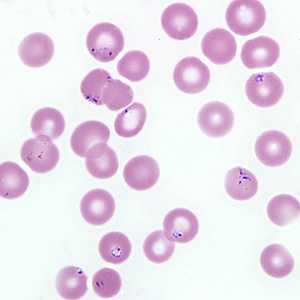
Case #218 - December, 2007
A 52-year-old man was seen at a hospital for fever and chills. He reported travel to wooded areas in the Northeastern United States and noted previous tick bites. For the last case study of the year, you do not have to make a diagnosis since Babesia sp. was identified on a Giemsa-stained blood smear by the hospital laboratory staff. However, the attending physician would like a parasitemia value to determine how best to manage the care and treatment of the patient. Using the images provided, please calculate the parasitemia. Happy holidays!

Figure A

Figure B

Figure C
Case Answer
The parasitemia for this case of babesiosis was approximately 23%. For this case, a stained thin smear was examined and parasitemia was expressed as the percentage of red blood cells (RBCs) infected, not the number of parasites observed. Counting the number of parasites could lead to an inaccurately high value and may lead to more aggressive therapy than necessary. When using this approach, report the number of infected RBCs per 100 RBCs; a minimum of 500-2,000 RBCs should be counted. Due to the constraints of presenting this as a case study, we only showed three images with about 30 RBCs each. The values for the images should be approximately as follows:
- Figure A – 6 infected RBCs out 28 RBCs
- Figure B – 9 infected RBCs out of 29 RBCs
- Figure C – 5 infected RBCs out of 29 RBCs
These counts give an average of 6.6 infected RBCs per 28.6 RBCs or 23% of RBCs infected. In areas endemic for malaria, the thick blood smear is generally used for calculating parasitemia: if the white blood cell count is known, the parasitemia can be estimated as the number of parasites per microliter of blood. Another approach that can used for either thick or thin smears is to count the number of parasites per 100 white blood cells (WBCs); this number can also be converted to the number of parasites per microliter of blood.
More on: Calculating Parasitemias
Images presented in the monthly case studies are from specimens submitted for diagnosis or archiving. On rare occasions, clinical histories given may be partly fictitious.
DPDx is an education resource designed for health professionals and laboratory scientists. For an overview including prevention and control visit www.cdc.gov/parasites/.
- Page last reviewed: August 24, 2016
- Page last updated: August 24, 2016
- Content source:
- Global Health – Division of Parasitic Diseases and Malaria
- Notice: Linking to a non-federal site does not constitute an endorsement by HHS, CDC or any of its employees of the sponsors or the information and products presented on the site.
- Maintained By:


 ShareCompartir
ShareCompartir